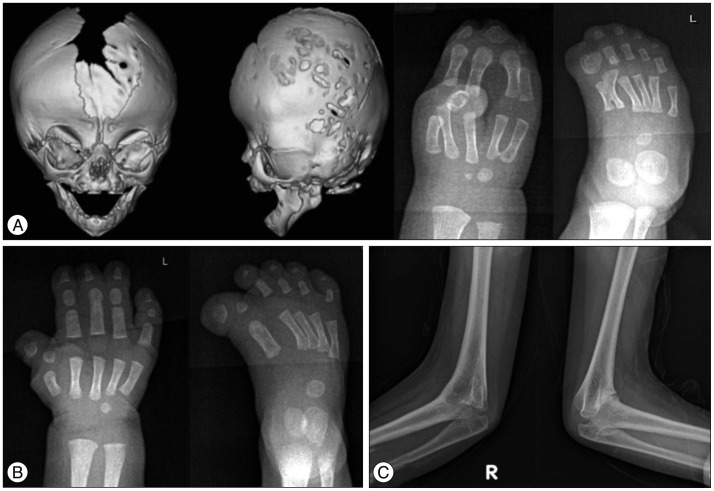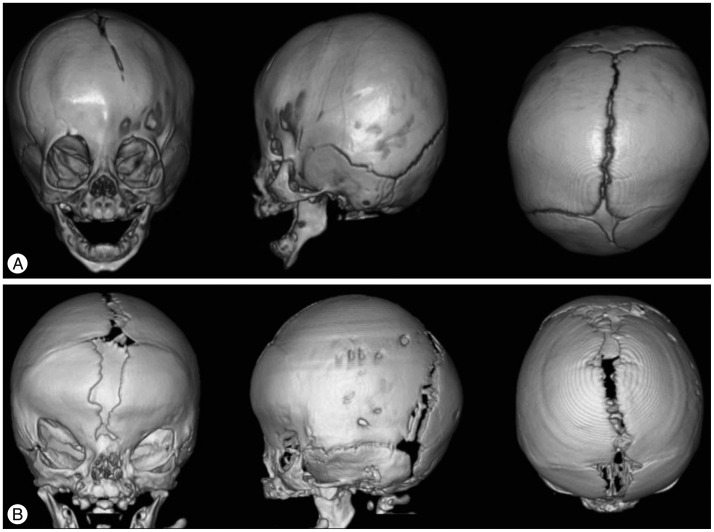J Korean Neurosurg Soc.
2016 May;59(3):187-191. 10.3340/jkns.2016.59.3.187.
Genetic Syndromes Associated with Craniosynostosis
- Affiliations
-
- 1Department of Pediatrics, Seoul National University College of Medicine, Seoul, Korea. jmko@snu.ac.kr
- KMID: 2192082
- DOI: http://doi.org/10.3340/jkns.2016.59.3.187
Abstract
- Craniosynostosis is defined as the premature fusion of one or more of the cranial sutures. It leads not only to secondary distortion of skull shape but to various complications including neurologic, ophthalmic and respiratory dysfunction. Craniosynostosis is very heterogeneous in terms of its causes, presentation, and management. Both environmental factors and genetic factors are associated with development of craniosynostosis. Nonsyndromic craniosynostosis accounts for more than 70% of all cases. Syndromic craniosynostosis with a certain genetic cause is more likely to involve multiple sutures or bilateral coronal sutures. FGFR2, FGFR3, FGFR1, TWIST1 and EFNB1 genes are major causative genes of genetic syndromes associated with craniosynostosis. Although most of syndromic craniosynostosis show autosomal dominant inheritance, approximately half of patients are de novo cases. Apert syndrome, Pfeiffer syndrome, Crouzon syndrome, and Antley-Bixler syndrome are related to mutations in FGFR family (especially in FGFR2), and mutations in FGFRs can be overlapped between different syndromes. Saethre-Chotzen syndrome, Muenke syndrome, and craniofrontonasal syndrome are representative disorders showing isolated coronal suture involvement. Compared to the other types of craniosynostosis, single gene mutations can be more frequently detected, in one-third of coronal synostosis patients. Molecular diagnosis can be helpful to provide adequate genetic counseling and guidance for patients with syndromic craniosynostosis.
Keyword
MeSH Terms
Figure
Reference
-
1. Arnaud E, Renier D, Marchac D. Prognosis for mental function in scaphocephaly. J Neurosurg. 1995; 83:476–479. PMID: 7666225.
Article2. Cai J, Goodman BK, Patel AS, Mulliken JB, Van Maldergem L, Hoganson GE, et al. Increased risk for developmental delay in Saethre-Chotzen syndrome is associated with TWIST deletions : an improved strategy for TWIST mutation screening. Hum Genet. 2003; 114:68–76. PMID: 14513358.
Article3. Cohen MM Jr, Kreiborg S, Lammer EJ, Cordero JF, Mastroiacovo P, Erickson JD, et al. Birth prevalence study of the Apert syndrome. Am J Med Genet. 1992; 42:655–659. PMID: 1303629.
Article4. Compagni A, Logan M, Klein R, Adams RH. Control of skeletal patterning by ephrinB1-EphB interactions. Dev Cell. 2003; 5:217–230. PMID: 12919674.
Article5. Doherty ES, Lacbawan F, Hadley DW, Brewer C, Zalewski C, Kim HJ, et al. Muenke syndrome (FGFR3-related craniosynostosis) : expansion of the phenotype and review of the literature. Am J Med Genet A. 2007; 143A:3204–3215. PMID: 18000976.6. El Ghouzzi V, Lajeunie E, Le Merrer M, Cormier-Daire V, Renier D, Munnich A, et al. Mutations within or upstream of the basic helix-loop-helix domain of the TWIST gene are specific to Saethre-Chotzen syndrome. Eur J Hum Genet. 1999; 7:27–33. PMID: 10094188.
Article7. Flück CE, Miller WL. P450 oxidoreductase deficiency : a new form of congenital adrenal hyperplasia. Curr Opin Pediatr. 2006; 18:435–441. PMID: 16915000.
Article8. Glaser RL, Jiang W, Boyadjiev SA, Tran AK, Zachary AA, Van Maldergem L, et al. Paternal origin of FGFR2 mutations in sporadic cases of Crouzon syndrome and Pfeiffer syndrome. Am J Hum Genet. 2000; 66:768–777. PMID: 10712195.
Article9. Goriely A, McVean GA, van Pelt AM, O'Rourke AW, Wall SA, de Rooij DG, et al. Gain-of-function amino acid substitutions drive positive selection of FGFR2 mutations in human spermatogonia. Proc Natl Acad Sci U S A. 2005; 102:6051–6056. PMID: 15840724.
Article10. Grutzner E, Gorlin RJ. Craniofrontonasal dysplasia : phenotypic expression in females and males and genetic considerations. Oral Surg Oral Med Oral Pathol. 1988; 65:436–444. PMID: 3283635.
Article11. Johnson D, Wilkie AO. Craniosynostosis. Eur J Hum Genet. 2011; 19:369–376. PMID: 21248745.
Article12. Kan SH, Elanko N, Johnson D, Cornejo-Roldan L, Cook J, Reich EW, et al. Genomic screening of fibroblast growth-factor receptor 2 reveals a wide spectrum of mutations in patients with syndromic craniosynostosis. Am J Hum Genet. 2002; 70:472–486. PMID: 11781872.
Article13. Kimonis V, Gold JA, Hoffman TL, Panchal J, Boyadjiev SA. Genetics of craniosynostosis. Semin Pediatr Neurol. 2007; 14:150–161. PMID: 17980312.
Article14. Kreiborg S, Cohen MM Jr. Is craniofacial morphology in Apert and Crouzon syndromes the same? Acta Odontol Scand. 1998; 56:339–341. PMID: 10066112.
Article15. Miller WL. P450 oxidoreductase deficiency : a new disorder of steroidogenesis with multiple clinical manifestations. Trends Endocrinol Metab. 2004; 15:311–315. PMID: 15350602.
Article16. Moloney DM, Wall SA, Ashworth GJ, Oldridge M, Glass IA, Francomano CA, et al. Prevalence of Pro250Arg mutation of fibroblast growth factor receptor 3 in coronal craniosynostosis. Lancet. 1997; 349:1059–1062. PMID: 9107244.
Article17. Mulliken JB, Steinberger D, Kunze S, Müller U. Molecular diagnosis of bilateral coronal synostosis. Plast Reconstr Surg. 1999; 104:1603–1615. PMID: 10541159.
Article18. Passos-Bueno MR, Serti Eacute AE, Jehee FS, Fanganiello R, Yeh E. Genetics of craniosynostosis : genes, syndromes, mutations and genotype-phenotype correlations. Front Oral Biol. 2008; 12:107–143. PMID: 18391498.19. Paznekas WA, Cunningham ML, Howard TD, Korf BR, Lipson MH, Grix AW, et al. Genetic heterogeneity of Saethre-Chotzen syndrome, due to TWIST and FGFR mutations. Am J Hum Genet. 1998; 62:1370–1380. PMID: 9585583.
Article20. Purushothaman R, Cox TC, Maga AM, Cunningham ML. Facial suture synostosis of newborn Fgfr1(P250R/+) and Fgfr2(S252W/+) mouse models of Pfeiffer and Apert syndromes. Birth Defects Res A Clin Mol Teratol. 2011; 91:603–609. PMID: 21538817.
Article21. Reardon W, Winter RM. Saethre-Chotzen syndrome. J Med Genet. 1994; 31:393–396. PMID: 8064818.
Article22. Reardon W, Winter RM, Rutland P, Pulleyn LJ, Jones BM, Malcolm S. Mutations in the fibroblast growth factor receptor 2 gene cause Crouzon syndrome. Nat Genet. 1994; 8:98–103. PMID: 7987400.
Article23. Schell U, Hehr A, Feldman GJ, Robin NH, Zackai EH, de Die-Smulders C, et al. Mutations in FGFR1 and FGFR2 cause familial and sporadic Pfeiffer syndrome. Hum Mol Genet. 1995; 4:323–328. PMID: 7795583.
Article24. Slaney SF, Oldridge M, Hurst JA, Moriss-Kay GM, Hall CM, Poole MD, et al. Differential effects of FGFR2 mutations on syndactyly and cleft palate in Apert syndrome. Am J Hum Genet. 1996; 58:923–932. PMID: 8651276.25. Twigg SR, Babbs C, van den Elzen ME, Goriely A, Taylor S, McGowan SJ, et al. Cellular interference in craniofrontonasal syndrome : males mosaic for mutations in the X-linked EFNB1 gene are more severely affected than true hemizygotes. Hum Mol Genet. 2013; 22:1654–1662. PMID: 23335590.
Article27. Wieacker P, Wieland I. Clinical and genetic aspects of craniofrontonasal syndrome : towards resolving a genetic paradox. Mol Genet Metab. 2005; 86:110–116. PMID: 16143553.
Article28. Wilkie AO, Byren JC, Hurst JA, Jayamohan J, Johnson D, Knight SJ, et al. Prevalence and complications of single-gene and chromosomal disorders in craniosynostosis. Pediatrics. 2010; 126:e391–e400. PMID: 20643727.
Article29. Williamson L, Arlt W, Shackleton C, Kelley RI, Braddock SR. Linking Antley-Bixler syndrome and congenital adrenal hyperplasia : a novel case of P450 oxidoreductase deficiency. Am J Med Genet A. 2006; 140A:1797–1803. PMID: 16906539.
- Full Text Links
- Actions
-
Cited
- CITED
-
- Close
- Share
- Similar articles
-
- Update of Diagnostic Evaluation of Craniosynostosis with a Focus on Pediatric Systematic Evaluation and Genetic Studies
- The pathogenesis of craniosynostosis in the fetus
- Craniosynostosis Occurring between Siblings
- Mercedes Benz Pattern Craniosynostosis: A Case Report
- Current and Future Perspectives in Craniosynostosis



